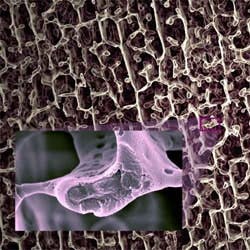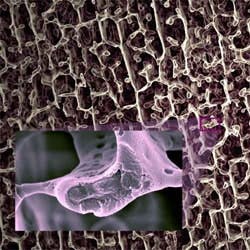Unique Foams Promise Better Gas Sensors
Solid foams made from colloids containing a polymer latex and nanoparticles may lead to lower-cost, more-responsive, low-power room-temperature gas sensors, believe researchers at the University of Warwick, Coventry, U.K. The simple and cheap fabrication process for the foams potentially offers both technical and economic advantages, they add.The foams are made from a multi-component mixture of colloids in one step via freeze-drying. The colloids consist of a blend of larger “soft” polymer latexes (with diameters in the range of 200 nm–500 nm) and small (25 nm–35 nm) “hard” nanoparticles. As the mixture freezes, the nanoparticles tend to accumulate near the surface of the growing ice crystals. Sublimation then results in a structured foam with armored cells. This scaffolding reinforces the polymer matrix, enhancing mechanical stability of the foam. It also introduces a tailored surface functionality that may prove of great value for foam applications involving adhesion or adsorption, say the researchers.
Unique Foam
Figure 1. Freeze drying leads to foam with hard nanoparticles near cell walls; inset shows magnified section. Source: University of Warwick.So far, they have worked with poly (vinyl laureate) latexes and silica, Laponite clay and aluminum oxide nanoparticles, as well as small polystyrene latex particles. Adding a third component, about-120-nm carbon black particles (at a level of 14 wt. % in the final solid), makes the foam conductive and thus suitable for sensors.Foams incorporated on printed circuit boards have shown differing sensitivities to various hydrocarbon gases and linear responsiveness.“This new process allows us to create interesting foam-based nanocomposite materials which show promising results as gas sensors that can operate at room temperature and differ from traditional metal-oxide-based sensors. We know that existing chemical sensors formed from composites of carbon black particulates and insulating polymers have been previously shown to form room-temperature (thus low-power) chemical sensors for detecting a range of volatile organic compounds. Now in one step we can place the same material in a high-tech polymer foam to create a new range of gas-sensor devices. We believe these materials could become a new generation of sensing porous films,” says Stefan Bon, lead researcher and associate professor of polymer chemistry.Changing nanoparticle/polymer latex ratios and individual concentrations as well as nanoparticle type enables some control over pore structure and overall porosity of the foams. More details appear in a recent paper in Advanced Materials.“Key challenges are to make the foams responsive selectively to a specific vapor, gas or biological entity, to generate armored foams which can operate over a window of external conditions, such as a wide range of temperatures, and to assess the optimal pore structure and colloid combination for fast response times and sensitivity,” notes Bon.The next step is to address these challenges, he adds. “The foam fabrication process in itself is elegantly simple, which makes it feasible to generate arrays of different foam compositions which can be analyzed in parallel on printed circuit boards.”“In principle, there are no limitations to scale up to larger dimensions. More interestingly is how small we can make the piece of foam that needs to be integrated in a sensory device. We already have started to look at this,” says Bon.“The costs are extremely low, as the current colloidal building blocks are very cheap. The main cost would be the freeze-drying process and the integration of the foam on a printed circuit board,” he explains.“We are looking for an industrial partner to develop the process further and would be delighted with a collaboration for a specific target application,” stresses Bon. “I think with the right commercial partner we could come to a prototype within five years that would be more advanced and would target specific vapors.” 
